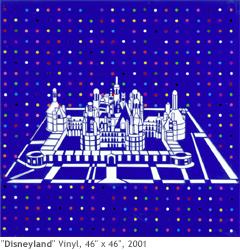Tamara Gayer
dal 26/6/2002 al 5/8/2002
Segnalato da
26/6/2002
Tamara Gayer
Priska C. Juschka Fine Art - Old location, New York
'Urbanics'. One can physically feel an optical flickering in all of Tamara Gayer's work. She posits two viable and coexistent realities that are in endless dialogue between themselves across the flat surface of the drawing. These operations don't reiterate issues regarding pictorial surface as we have known them to this point, but serve to completely move beyond the surface of things.

"Urbanics"
2001-2002
One can physically feel an optical flickering in all of Tamara Gayer's work. She posits two viable and coexistent realities that are in endless dialogue between
themselves across the flat surface of the drawing. These operations don't reiterate issues regarding pictorial surface as we have known them to this point, but
serve to completely move beyond the surface of things. She allows us to be both inside and outside at the same time as her subject matter moves from XS to
XL, or from the domestic to the urban scale.
In addressing the domestic Gayer creates images of canonical 20th c. modern houses. The play of visual recognition of the exterior of these icons is
sandwiched with the truly haptic, liminal, and non-representational space of the internal body of the domestic. We can't see these spaces; we can only feel
them. Turning to the urban scale she uses a background grid to pull against the perspectival representations of architectural icons of modernity. In the series
(Atomic Albany, Ferrari, Skyscraper, Vegas) she creates a tension in the drawn spaces of these buildings. We are pushed and pulled against the grain of the
grid. The grid may refer to the urban scale in which these seminal buildings are hidden. They refer equally to the large-scale organizations of Hausmann's
Paris plan, or the city grids of Washington, D.C. or Barcelona as to modernist painterly notions of the grid. There are uncanny moments when the horizon, or
eye level that locates us in relation to the perspectival view of the architecture, merges fully with the line of the grid. In this moment we are irrevocably in the
seam between the object and the field, the surface and depth, in a robust space of deep flatness. We are in and outside of our body, within and outside the
visual field.
Using translucent surfaces Gayer posits these images either traditionally on the wall like paintings or suspended in space like architectural constructions.
The large-scale translucent drawings are hung in a staggered fashion at a distance within the gallery. As spectators, we are urged to question what our eye
takes in and how a more visceral understanding of the drawings at close scale can challenge that. Using bright opaque colors, Gayer further plays with
perceptions of luminosity and flatness, when surfaces that appear 'hard edge' from afar turn out to be lusciously 'brushy' and 'drippy' from up close. The
staccato patterning of the coloration of the elements contributes to the movement within the drawing. The drawing surface ebbs and flows in hosting the
constant construction and deconstruction of the referential image.
Her latest work indicates a new subtle twist to these games. The figure of the architecture is made up of individual elements, which both inhabit the surface of
the drawing as disconnected individual elements and then oscillate in representing architectonic elements. This reveals a recurring thematic that is essential
to understand in relation to her work: that a view is constructed. Her unrelenting pursuit of modern spaces of domesticity and the urban are revealed to us in
drawings that instead of closing down and simply describing already known spaces to us, open up the endless spaces of the physical and mental, of our
mind and bodies.
Alicia Imperiale
Opening Reception: Thursday, June 27, 2002 6-9 pm
Gallery hours: Thursday - Monday, 12 - 6 pm or
by appointment
priska juschka fineart
97 North 9th Street, (between Berry Street & Wythe Ave.) Brooklyn, NY 11211
T: 212 987-6177 new: T: 718-782-4100
F: 212 987-6182 new: F: 718-782-4800



